Recession, Local Fertility, and Urban Sustainability: Results of a Quasi-Experiment in Greece, 1991–2018
Abstract
1. Introduction
2. Methodology
2.1. Study Area
2.2. Data and Indicators
2.3. Data Analysis
3. Results
3.1. A Descriptive Analysis of Local Fertility Rates in Athens, 1991–2018
3.2. Spatial Analysis, 1999–2018
3.3. Gross Fertility Rates and Socioeconomic Local Contexts
4. Discussion
5. Conclusions
Author Contributions
Funding
Conflicts of Interest
References
- Adserà, A. Changing fertility rates in developed countries. The impact of labor market institutions. J. Popul. Econ. 2004, 17, 17–43. [Google Scholar] [CrossRef]
- Bayona-Carrasco, J.; Gil-Alonso, F. Suburbanisation and international immigration: The case of the Barcelona Metropolitan Region (1998–2009). Tijdschr. Voor Econ. En Soc. Geogr. 2012, 103, 312–329. [Google Scholar] [CrossRef]
- Bocquier, P.; Costa, R. Which transition comes first? Urban and demographic transitions in Belgium and Sweden. Demogr. Res. 2015, 33, 1297–1332. [Google Scholar] [CrossRef]
- Buckley, C. Rural/urban differentials in demographic processes: The Central Asian states. Popul. Res. Policy Rev. 1998, 17, 71–89. [Google Scholar] [CrossRef]
- Caldwell, J.C. Demographic Transition Theory; Springer: Berlin, Germany, 2006. [Google Scholar]
- Chelli, F.M.; Ciommi, M.; Emili, A.; Gigliarano, C.; Taralli, S. Assessing the Equitable and Sustainable Well-Being of the Italian Provinces. Int. J. Uncertain. Fuzziness Knowl. Based Syst. 2016, 24, 39–62. [Google Scholar] [CrossRef]
- Evans, A.; Gray, E. Modelling Variation in Fertility Rates Using Geographically Weighted Regression. Spat. Demogr. 2018, 6, 121–140. [Google Scholar] [CrossRef]
- Gavalas, V.S.; Rontos, K.; Salvati, L. Who becomes an unwed mother in Greece? Socio-demographic and geographical aspects of an emerging phenomenon. Popul. Space Place 2014, 20, 250–263. [Google Scholar] [CrossRef]
- Goldstein, J.R.; Klüsener, S. Spatial analysis of the causes of the fertility decline in Prussia. Popul. Dev. Rev. 2014, 40, 497–525. [Google Scholar] [CrossRef]
- Guilmoto, C.Z.; Rajan, S.I. Spatial patterns of fertility transition in Indian districts. Popul. Dev. Rev. 2001, 27, 713–738. [Google Scholar] [CrossRef]
- Işik, O.; Pinarcioglu, M.M. Geographies of a silent transition: A geographically weighted regression approach to regional fertility differences in Turkey. Eur. J. Popul. 2006, 22, 399–421. [Google Scholar] [CrossRef]
- Kulu, H. Why do fertility levels vary between urban and rural areas? Reg. Stud. 2013, 47, 895–912. [Google Scholar] [CrossRef]
- Kulu, H.; Boyle, P.J.; Anderson, G. High Suburban fertility: Evidence from Four Northern European Countries. Demogr. Res. 2009, 31, 915–944. [Google Scholar] [CrossRef]
- Lauf, S.; Haase, D.; Seppelt, R.; Schwarz, N. Simulating demography and housing demand in an urban region under scenarios of growth and shrinkage. Environ. Plan. B Plan. Des. 2012, 39, 229–246. [Google Scholar] [CrossRef]
- Lerch, M. Fertility decline during Albania’s societal crisis and its subsequent consolidation. Eur. J. Popul. 2013, 29, 195–220. [Google Scholar] [CrossRef]
- Lerch, M. Regional variations in the rural-urban fertility gradients in global South. PLoS ONE 2019, 14, 1–19. [Google Scholar] [CrossRef] [PubMed]
- Lesthaeghe, R.; Lopez-Gay, A. Spatial continuities and discontinuities in two successive demographic transitions: Spain and Belgium, 1880–2010. Demogr. Res. 2013, 28, 77–136. [Google Scholar] [CrossRef]
- Liu, L. Fertility trends in China’s more developed urban districts: The case of four cities. Popul. Space Place 2005, 11, 411–424. [Google Scholar] [CrossRef]
- Michielin, F. Lowest low fertility in an urban context: The role of migration in Turin, Italy. Popul. Space Place 2004, 10, 331–347. [Google Scholar] [CrossRef]
- Potter, J.E.; Schmertmann, C.P.; Assunção, R.M.; Cavenaghi, S.M. Mapping the timing, pace, and scale of the fertility transition in Brazil. Popul. Dev. Rev. 2010, 36, 283–307. [Google Scholar] [CrossRef]
- Rontos, K. Prospects for a new family formation and for its impact on fertility: Some research evidences from Greece. Stat. Rev. 2007, 3, 1–9. [Google Scholar]
- Sabater, A.; Graham, E. International migration and fertility variation in Spain during the economic recession: A spatial Durbin approach. Appl. Spat. Anal. Policy 2019, 12, 515–546. [Google Scholar] [CrossRef]
- Schneider, D. The Great Recession, fertility, and uncertainty: Evidence from the United States. J. Marriage Fam. 2015, 77, 1144–1156. [Google Scholar] [CrossRef]
- Sobotka, T. Postponement of Childbearing and Low Fertility in Europe; Dutch University Press: Amsterdam, The Netherlands, 2004. [Google Scholar]
- Sobotka, T.; Skirbekk, V.; Philipov, D. Economic recession and fertility in the developed world. Popul. Dev. Rev. 2011, 37, 267–306. [Google Scholar] [CrossRef] [PubMed]
- Surkyn, J.; Lesthaeghe, R. Value orientations and the second demographic transition (SDT) in Northern, Western and Southern Europe: An update. Demogr. Res. 2004, 3, 45–86. [Google Scholar] [CrossRef]
- Thygesen, L.C.; Knudsen, L.B.; Keiding, N. Modelling regional variation of first-time births in Denmark 1980-1994 by an age-period-cohort model. Demogr. Res. 2005, 13, 573–590. [Google Scholar] [CrossRef]
- Van de Kaa, D.J. Europe’s second demographic transition. Popul. Bull. 1987, 42, 1–59. [Google Scholar]
- Vitali, A.; Billari, F.C. Changing determinants of low fertility and diffusion: A spatial analysis for Italy. Popul. Space Place 2017, 23, e1998. [Google Scholar] [CrossRef]
- Vignoli, D.; Drefahl, S.; De Santis, G. Whose job instability affects the likelihood of becoming a parent in Italy? A tale of two partners. Demogr. Res. 2012, 26, 41–62. [Google Scholar] [CrossRef]
- Walford, N.; Kurek, S. Outworking of the Second Demographic Transition: National Trends and Regional Patterns of Fertility Change in Poland, and England and Wales, 2002–2012. Popul. Space Place 2016, 22, 508–525. [Google Scholar] [CrossRef]
- Van Bavel, J. The reversal of gender inequality in education, union formation and fertility in Europe. Vienna Yearb. Popul. Res. 2012, 10, 127–154. [Google Scholar] [CrossRef]
- Rontos, K. Demographic trends, young people’s attitudes towards marriage and socio-economic changes related to family formation in Greece and in selected European Countries: A comparative analysis based on official and survey research data. Int. J. Criminol. Sociol. Theory 2010, 3, 543–562. [Google Scholar]
- Rodriguez-Rodriguez, V. The seven demographic Spains. Inter-municipal contrasts in age structure: Fertility and migration are the determining factors. Espace Popul. Soc. 2000, 18, 425–435. [Google Scholar]
- Wachter, K.W. Spatial demography. Proc. Natl. Acad. Sci. USA 2005, 102, 15299–15300. [Google Scholar] [CrossRef]
- Voss, P.R. Demography as a spatial social science. Popul. Res. Policy Rev. 2007, 26, 457–476. [Google Scholar] [CrossRef]
- Waldorf, B.; Franklin, R. Spatial dimensions of the Easterlin hypothesis: Fertility variations in Italy. J. Reg. Sci. 2002, 42, 549–578. [Google Scholar] [CrossRef]
- Adsera, A. An Economic Analysis of the Gap between Desired and Actual Fertility: The Case of Spain. Rev. Econ. Househ. 2006, 4, 75–95. [Google Scholar] [CrossRef]
- Arpino, B.; Patrício Tavares, L. Fertility and Values in Italy and Spain: A Look at Regional Differences within the European Context. Popul. Rev. 2013, 52, 62–86. [Google Scholar]
- Billari, F.; Kohler, H.P. Patterns of low and lowest-low fertility in Europe. Popul. Stud. 2004, 58, 161–176. [Google Scholar] [CrossRef]
- Cabré, A. Facts and Factors on Low Fertility in Southern Europe. The Case of Spain. J. Popul. Soc. Secur. (Popul.) 2003, S1, 309–321. [Google Scholar]
- Bongaarts, J.; Watkins, S.C. Social Interactions and Contemporary Fertility Transitions. Popul. Dev. Rev. 1996, 22, 639–682. [Google Scholar] [CrossRef]
- Caldwell, J.C.; Schindlmayr, T. Explanations of the fertility crisis in modern societies: A search for commonalities. Popul. Stud. 2003, 57, 241–263. [Google Scholar] [CrossRef] [PubMed]
- Caltabiano, M. Has the fertility decline come to an end in the different regions of Italy? New insights from a cohort approach. Population 2008, 63, 157–172. [Google Scholar] [CrossRef]
- Carlucci, M.; Chelli, F.M.; Salvati, L. Toward a new cycle: Short-term population dynamics, gentrification, and re-urbanization of Milan (Italy). Sustainability 2018, 10, 3014. [Google Scholar] [CrossRef]
- Chelli, F.; Gigliarano, C.; Mattioli, E. The impact of inflation on heterogeneous groups of households: An application to Italy. Econ. Bull. 2009, 29, 1276–1295. [Google Scholar]
- Cherlin, A.; Cumberworth, E.; Morgan, S.P.; Wimer, C. The effects of the Great Recession on family structure and fertility. Ann. Am. Acad. Political Soc. Sci. 2013, 650, 214–223. [Google Scholar] [CrossRef]
- Ciganda, D. Unstable work histories and fertility in France: An adaptation of sequence complexity measures to employment trajectories. Demogr. Res. 2015, 32, 843–876. [Google Scholar] [CrossRef]
- Ciommi, M.; Chelli, F.M.; Carlucci, M.; Salvati, L. Urban growth and demographic dynamics in southern Europe: Toward a new statistical approach to regional science. Sustainability 2018, 10, 2765. [Google Scholar] [CrossRef]
- Coppola, L.; Di Cesare, M. How fertility and union stability interact in shaping new family patterns in Italy and Spain. Demogr. Res. 2008, 18, 117–144. [Google Scholar] [CrossRef]
- Del Bono, E.; Weber, A.; Winter-Ebmer, R. Fertility and economic instability: The role of unemployment and job displacement. J. Popul. Econ. 2015, 28, 46–479. [Google Scholar]
- Frejka, T.; Sobotka, T. Fertility in Europe: Diverse, delayed and below replacement. Demogr. Res. 2008, 19, 15–46. [Google Scholar] [CrossRef]
- Georgiadis, K. Fertile debates: A comparative account of low fertility in the British and Greek national press. Eur. J. Popul. 2011, 27, 243–262. [Google Scholar] [CrossRef][Green Version]
- Goldstein, J.; Kreyenfeld, M.; Jasilioniene, A.; Örsal, D.D.K. Fertility reactions to the “Great Recession” in Europe: Recent evidence from order-specific data. Demogr. Res. 2013, 29, 85–104. [Google Scholar] [CrossRef]
- Hofmann, B.; Hohmeyer, K. Perceived economic uncertainty and fertility: Evidence from a labor market reform. J. Marriage Fam. 2013, 75, 503–521. [Google Scholar] [CrossRef]
- Kreyenfeld, M. Uncertainties in female employment careers and the postponement of parenthood in Germany. Eur. Sociol. Rev. 2010, 26, 351–366. [Google Scholar] [CrossRef]
- Lee, K.O.; Painter, G. What happens to household formation in a recession? J. Urban Econ. 2013, 76, 93–109. [Google Scholar] [CrossRef]
- Modena, F.; Rondinelli, C.; Sabatini, F. Economic insecurity and fertility intentions: The case of Italy. Rev. Income Wealth 2014, 60, S233–S255. [Google Scholar] [CrossRef]
- Schneider, F.; Kallis, G.; Martinez-Alier, J. Crisis or opportunity? Economic degrowth for social equity and ecological sustainability. J. Clean. Prod. 2010, 18, 511–518. [Google Scholar] [CrossRef]
- Lesthaeghe, R.J.; Neidert, L. The second demographic transition in the United States: Exception or textbook example? Popul. Dev. Rev. 2006, 32, 669–698. [Google Scholar] [CrossRef]
- Martín García, T. The impact of occupational sex-composition on women’s fertility in Spain. Eur. Soc. 2010, 12, 113–133. [Google Scholar] [CrossRef]
- Morgan, S.P. Is low fertility a twenty-first-century demographic crisis? Demography 2003, 40, 589–603. [Google Scholar] [CrossRef]
- Cazzola, A.; Pasquini, L.; Angeli, A. The relationship between unemployment and fertility in Italy: A time-series analysis. Demogr. Res. 2016, 34, 1–3. [Google Scholar] [CrossRef]
- Caltabiano, M.; Castiglioni, M.; Rosina, A. Lowest-low fertility: Signs of a recovery in Italy? Demogr. Res. 2009, 21, 681–718. [Google Scholar] [CrossRef]
- Carbonaro, C.; Leanza, M.; McCann, P.; Medda, F. Demographic decline, population aging, and modern financial approaches to urban policy. Int. Reg. Sci. Rev. 2018, 41, 210–232. [Google Scholar] [CrossRef]
- Chelli, F.; Rosti, L. Age and gender differences in Italian workers’ mobility. Int. J. Manpow. 2002, 23, 313–325. [Google Scholar] [CrossRef]
- Hondroyiannis, G.; Papapetrou, E. Demographic transition and economic growth: Empirical evidence from Greece. J. Popul. Econ. 2002, 15, 221–242. [Google Scholar] [CrossRef]
- Kirk, D. Demographic transition theory. Popul. Stud. 1996, 50, 361–387. [Google Scholar] [CrossRef]
- Kabisch, N.; Haase, D. Diversifying European agglomerations: Evidence of urban population trends for the 21st century. Popul. Space Place 2011, 17, 236–253. [Google Scholar] [CrossRef]
- Kreyenfeld, M.; Andersson, G.; Pailhé, A. Economic uncertainty and family dynamics in Europe: Introduction. Demogr. Res. 2012, 27, 835–852. [Google Scholar] [CrossRef]
- Martin-Garcia, T.; Castro-Martín, T. Do women working in the public sector have it easier to become mothers in Spain? Popul. Rev. 2013, 52, 149–171. [Google Scholar]
- Bocquier, P.; Bree, S. A regional perspective on the economic determinants of urban transition in 19th-century France. Demogr. Res. 2018, 38, 1535–1576. [Google Scholar] [CrossRef]
- Balbo, N.; Billari, F.C.; Mills, M. Fertility in advanced societies: A review of research. Eur. J. Popul. 2013, 29, 1–38. [Google Scholar] [CrossRef] [PubMed]
- Buzar, S.; Ogden, P.E.; Hall, R. Households matter: The quiet demography of urban transformation. Prog. Hum. Geogr. 2005, 29, 413–436. [Google Scholar] [CrossRef]
- Castro, M.C. Spatial demography: An opportunity to improve policy making at diverse decision levels. Popul. Res. Policy Rev. 2007, 26, 477–509. [Google Scholar] [CrossRef]
- Chi, G.; Zhu, J. Spatial regression models for demographic analysis. Popul. Res. Policy Rev. 2008, 27, 17–42. [Google Scholar] [CrossRef]
- Ciommi, M.; Gigliarano, C.; Emili, A.; Taralli, S.; Chelli, F.M. A new class of composite indicators for measuring well-being at the local level: An application to the Equitable and Sustainable Well-being (BES) of the Italian Provinces. Ecol. Indic. 2017, 76, 281–296. [Google Scholar] [CrossRef]
- Cooke, L.P. Gender equity and fertility in Italy and Spain. J. Soc. Policy 2009, 38, 123–140. [Google Scholar] [CrossRef]
- Goldstein, J.R.; Sobotka, T.; Jasilioniene, A. The end of lowest-low fertility? Popul. Dev. Rev. 2009, 35, 663–700. [Google Scholar]
- Kohler, H.P.; Billari, F.C.; Ortega, J.A. The emergence of lowest-low fertility in Europe during the 1990s. Popul. Dev. Rev. 2002, 28, 641–680. [Google Scholar] [CrossRef]
- Kaika, M. The economic crisis seen from the everyday: Europe’s nouveau poor and the global affective implications of a ‘local’ debt crisis. City 2012, 16, 422–430. [Google Scholar] [CrossRef]
- Hank, K. Regional social contexts and individual fertility decisions: A multilevel analysis of first and second births in western Germany. Eur. J. Popul. 2002, 18, 281–299. [Google Scholar] [CrossRef]
- Haase, A.; Kabisch, S.; Steinführer, A.; Bouzarovski, S.; Hall, R.; Ogden, P. Spaces of reurbanisation: Exploring the demographic dimension of inner-city residential change in a European setting. Popul. Space Place 2010, 16, 443–463. [Google Scholar] [CrossRef]
- Kroll, F.; Kabisch, N. The Relation of Diverging Urban Growth Processes and Demographic Change along an Urban-Rural Gradient, Population. Space Place 2012, 18, 260–276. [Google Scholar] [CrossRef]
- Lerch, M. The role of migration in the urban transition: A demonstration from Albania. Demography 2014, 51, 1527–1550. [Google Scholar] [CrossRef] [PubMed]
- Ogden, P.E.; Hall, R. Households, reurbanisation and the rise of living alone in the principal French cities 1975–1990. Urban Stud. 2000, 37, 367–390. [Google Scholar] [CrossRef]
- Pison, G. Two children per woman in France in 2010: Is French fertility immune to economic crisis? Popul. Soc. 2011, 476, 1. [Google Scholar]
- Pérez, J.M.G. The real estate and economic crisis: An opportunity for urban return and rehabilitation policies in Spain. Sustainability 2010, 2, 1571–1601. [Google Scholar] [CrossRef]
- Panori, A.; Psycharis, Y.; Ballas, D. Spatial segregation and migration in the city of Athens: Investigating the evolution of urban socio-spatial immigrant structures. Popul. Space Place 2018, 25, e2209. [Google Scholar] [CrossRef]
- Rees, P.; Bell, M.; Kupiszewski, M.; Kupiszewska, D.; Ueffing, P.; Bernard, A.; Edwards, E.C.; Stillwell, J. The impact of internal migration on population redistribution: An international comparison. Popul. Space Place 2017, 23, e2036. [Google Scholar] [CrossRef]
- Stockdale, A. Contemporary and ‘Messy’ Rural In-migration Processes: Comparing Counterurban and Lateral Rural Migration. Popul. Space Place 2016, 22, 599–616. [Google Scholar] [CrossRef]
- Kulu, H.; Boyle, P.J. High fertility in city suburbs: Compositional or contextual effects? Eur. J. Popul. 2009, 25, 157–174. [Google Scholar] [CrossRef]
- Kulu, H.; Vikat, A. Fertility differences by housing type: The effect of housing conditions or of selective moves? Demogr. Res. 2007, 17, 775–802. [Google Scholar] [CrossRef]
- Arapoglou, V.P.; Sayas, J. New facets of urban segregation in southern Europe—gender, migration and social class change in Athens. Eur. Urban Reg. Stud. 2009, 16, 345–362. [Google Scholar] [CrossRef]
- Angel, S.; Parent, J.; Civco, D.L.; Blei, A.; Potere, D. The dimensions of global urban expansion: Estimates and projections for all countries, 2000–2050. Prog. Plan. 2011, 75, 53–107. [Google Scholar] [CrossRef]
- Gil-Alonso, F.; Bayona-i-Carrasco, J.; Pujadas-i-Rúbies, I. From boom to crash: Spanish urban areas in a decade of change (2001–2011). Eur. Urban Reg. Stud. 2016, 23, 198–216. [Google Scholar] [CrossRef]
- Lerch, M. Internal and international migration across the urban hierarchy in Albania. Popul. Res. Policy Rev. 2016, 35, 851–876. [Google Scholar] [CrossRef] [PubMed]
- Chorianopoulos, I.; Tsilimigkas, G.; Koukoulas, S.; Balatsos, T. The shift to competitiveness and a new phase of sprawl in the Mediterranean city: Enterprises guiding growth in Messoghia–Athens. Cities 2014, 39, 133–143. [Google Scholar] [CrossRef]
- Tragaki, A.; Bagavos, C. Fertility variations in the recession context: The case of Greece. Genus 2019, 75, 18. [Google Scholar] [CrossRef]
- Tragaki, A.; Bagavos, C. Male fertility in Greece: Trends and differentials by educational level and employment status. Demogr. Res. 2014, 31, 137–160. [Google Scholar] [CrossRef]
- Salvati, L. The dark side of the crisis: Disparities in per-capita income (2000–2012) and the urban-rural gradient in Greece. Tijdschrift voor Economische en Sociale Geografie 2016, 107, 628–641. [Google Scholar] [CrossRef]
- Salvati, L.; Ferrara, A.; Chelli, F. Long-term growth and metropolitan spatial structures: An analysis of factors influencing urban patch size under different economic cycles. Geogr. Tidsskr. Dan. J. Geogr. 2018, 118, 56–71. [Google Scholar] [CrossRef]
- Rontos, K.; Grigoriadis, S.; Sateriano, A.; Syrmali, M.; Vavouras, I.; Salvati, L. Lost in Protest, Found in Segregation: Divided Cities in the Light of the 2015 ‘Oki’ Referendum in Greece. City Cult. Soc. 2016, 7, 139–148. [Google Scholar] [CrossRef]
- Ciommi, M.; Chelli, F.M.; Salvati, L. Integrating parametric and non-parametric multivariate analysis of urban growth and commuting patterns in a European metropolitan area. Qual. Quant. 2019, 53, 957–979. [Google Scholar] [CrossRef]
- Gkartzios, M. ‘Leaving Athens’: Narratives of counterurbanisation in times of crisis. J. Rural Stud. 2013, 32, 158–167. [Google Scholar] [CrossRef]
- Souliotis, N. Cultural economy, sovereign debt crisis and the importance of local contexts: The case of Athens. Cities 2013, 33, 61–68. [Google Scholar] [CrossRef]
- Remoundou, K.; Gkartzios, M.; Garrod, G. Conceptualizing Mobility in Times of Crisis: Towards Crisis-Led Counterurbanization? Reg. Stud. 2016, 50, 1663–1674. [Google Scholar] [CrossRef]
- Gkartzios, M.; Scott, K. A cultural panic in the province? Counterurban mobilities, creativity, and crisis in Greece. Popul. Space Place 2015, 21, 843–855. [Google Scholar] [CrossRef]
- Dijkstra, L.; Garcilazo, E.; McCann, P. The effects of the global financial crisis on European regions and cities. J. Econ. Geogr. 2015, 15, 935–949. [Google Scholar] [CrossRef]
- Muniz, J.O. Spatial dependence and heterogeneity in ten years of fertility decline in Brazil. Popul. Rev. 2009, 48, 32–65. [Google Scholar]
- Toulemon, L. Fertility among immigrant women: New data a new approach. Popul. Soc. 2004, 400, 1–4. [Google Scholar]
- Bagavos, C.; Verropoulou, G.; Tsimbos, C. Assessing the contribution of foreign women to period fertility in Greece, 2004–2012. Population 2018, 73, 115–130. [Google Scholar]
- Adsera, A. Marital fertility and religion in Spain, 1985 and 1999. Popul. Stud. 2006, 60, 205–221. [Google Scholar] [CrossRef] [PubMed]
- Gigliarano, C.; Chelli, F.M. Measuring inter-temporal intragenerational mobility: An application to the Italian labour market. Qual. Quant. 2016, 50, 89–102. [Google Scholar] [CrossRef]
- Kalwij, A. The impact of family policy expenditure on fertility in western Europe. Demography 2010, 47, 503–519. [Google Scholar] [CrossRef]
- Rosti, L.; Chelli, F. Higher education in non-standard wage contracts. Educ. Train. 2012, 54, 142–151. [Google Scholar] [CrossRef]
- Lamonica, G.R.; Chelli, F.M. The performance of non-survey techniques for constructing sub-territorial input-output tables. Pap. Reg. Sci. 2018, 97, 1169–1202. [Google Scholar] [CrossRef]
- Garcia, M. The breakdown of the Spanish urban growth model: Social and territorial effects of the global crisis. Int. J. Urban Reg. Res. 2010, 34, 967–980. [Google Scholar] [CrossRef]
- Billari, F.C.; Kohler, H.-P.; Andersson, G.; Lundström, H. Approaching the limit: Long-term trends in late and very late fertility. Popul. Dev. Rev. 2007, 33, 149–170. [Google Scholar] [CrossRef]
- Oinonen, E. Starting the first family. Chang. Patterns Fam. Form. Demogr. Trends Finl. Spain. Eur. Soc. 2004, 6, 319–346. [Google Scholar] [CrossRef]
- Palloni, A.; Tienda, M. Demographic responses to economic recessions in Latin America since 1900. Sociol. Inq. 1992, 62, 246–270. [Google Scholar] [CrossRef]
- De Beer, J.; Deerenberg, I. An explanatory model for projecting regional fertility differences in the Netherlands. Popul. Res. Policy Rev. 2007, 26, 511–528. [Google Scholar] [CrossRef]
- Wang, D.; Chi, G. Different Places, Different Stories: A Study of Spatial Heterogeneity of County-Level Fertility in China. Demogr. Res. 2017, 37, 493. [Google Scholar] [CrossRef] [PubMed]
- Brodmann, S.; Esping-Andersen, G.; Güell, M. When Fertility is Bargained: Second Births in Denmark and Spain. Eur. Sociol. Rev. 2007, 23, 599–613. [Google Scholar] [CrossRef]
- Rosti, L.; Chelli, F. Self-employment among Italian female graduates. Educ. Train. 2009, 51, 526–540. [Google Scholar] [CrossRef]
- Strozza, S.; Benassi, F.; Ferrara, R.; Gallo, G. Recent demographic trends in the major Italian urban agglomerations: The role of foreigners. Spat. Demogr. 2016, 4, 39–70. [Google Scholar] [CrossRef]
- Benassi, F.; Bonifazi, C.; Heins, F.; Lipizzi, F.; Strozza, S. Comparing residential segregation of migrant populations in selected European Urban and metropolitan areas. Spat. Demogr. 2020, 1–22. [Google Scholar] [CrossRef]
- Benassi, F.; Iglesias-Pascual, R.; Salvati, L. Residential segregation and social diversification: Exploring spatial settlement patterns of foreign population in Southern European cities. Habitat Int. 2020, 101, 102200. [Google Scholar] [CrossRef]
- Salvati, L.; Benassi, F. Rise (and Decline) of European Migrants in Greece: Exploring Spatial Determinants of Residential Mobility (1988–2017), with Special Focus on Older Ages. J. Int. Migr. Integr. 2020, 1–15. [Google Scholar] [CrossRef]
- López-Gay, A.; Andújar-Llosa, A.; Salvati, L. Residential Mobility, Gentrification and Neighborhood Change in Spanish Cities: A Post-Crisis Perspective. Spat. Demogr. 2020, 1–28. [Google Scholar] [CrossRef]
- Azarnert, L.V. Migration, Congestion and Growth. Macroecon. Dyn. 2019, 23, 3035–3064. [Google Scholar] [CrossRef]
- Lankford, H.; Wyckoff, J. The effect of school choice and residential location on the racial segregation of students. In Advances in Applied Microeconomics; Gronberg, T.J., Jensen, D.W., Eds.; Emerald Group Publishing Limited: Bingley, UK, 2006; Volume 14, pp. 185–239. [Google Scholar]
- Azarnert, L.V. Integrated Public Education, Fertility and Human Capital. Educ. Econ. 2014, 22, 166–180. [Google Scholar] [CrossRef]
- Maloutas, T.; Ramos Lobato, I. Education and social reproduction: Educational mechanisms and residential segregation in Athens and Dortmund. Local Econ. 2015, 30, 800–817. [Google Scholar] [CrossRef]
- Maloutas, T.; Spyrellis, S.N.; Capella, A. Residential segregation and educational performance. Case Athens. Urban Stud. 2019, 56, 3143–3161. [Google Scholar] [CrossRef]
- Maloutas, T. Middle class education strategies and residential segregation in Athens. J. Educ. Policy 2007, 22, 49–68. [Google Scholar] [CrossRef]
- Maloutas, T.; Spyrellis, S.; Hadjiyanni, A.; Capella, A.; Valassi, D. Residential and school segregation as parameters of educational performance in Athens. Cybergeo Eur. J. Geogr. 2019, 917, 1–20. [Google Scholar] [CrossRef]
- Zaidi, B.; Morgan, P. The second demographic transition theory: A Review and Appraisal. Annu. Rev. Sociol. 2017, 43, 473–492. [Google Scholar] [CrossRef]
- Butler, D. The fertility riddle. Nature 2004, 432, 38–39. [Google Scholar] [CrossRef]
- Bernardi, F. Public policies and low fertility: Rationales for public intervention and a diagnosis for the Spanish case. J. Eur. Soc. Policy 2005, 15, 123–138. [Google Scholar] [CrossRef]
- Oueslati, W.; Alvanides, S.; Garrod, G. Determinants of urban sprawl in European cities. Urban Stud. 2015, 52, 1594–1614. [Google Scholar] [CrossRef]
- Boyle, P. Population geography: Does geography matter in fertility research? Prog. Hum. Geogr. 2003, 27, 615–626. [Google Scholar] [CrossRef]
- Pili, S.; Grigoriadis, E.; Carlucci, M.; Clemente, M.; Salvati, L. Towards sustainable growth? A multi-criteria assessment of (changing) urban forms. Ecol. Indic. 2017, 76, 71–80. [Google Scholar] [CrossRef]
- Duvernoy, I.; Zambon, I.; Sateriano, A.; Salvati, L. Pictures from the other side of the fringe: Urban growth and peri-urban agriculture in a post-industrial city (Toulouse, France). J. Rural Stud. 2018, 57, 25–35. [Google Scholar] [CrossRef]
- Cuadrado-Ciuraneta, S.; Durà-Guimerà, A.; Salvati, L. Not only tourism: Unravelling suburbanization, second-home expansion and “rural” sprawl in Catalonia, Spain. Urban Geogr. 2017, 38, 66–89. [Google Scholar] [CrossRef]
- Salvati, L.; Zambon, I.; Chelli, F.M.; Serra, P. Do spatial patterns of urbanization and land consumption reflect different socioeconomic contexts in Europe? Sci. Total Environ. 2018, 625, 722–730. [Google Scholar] [CrossRef] [PubMed]
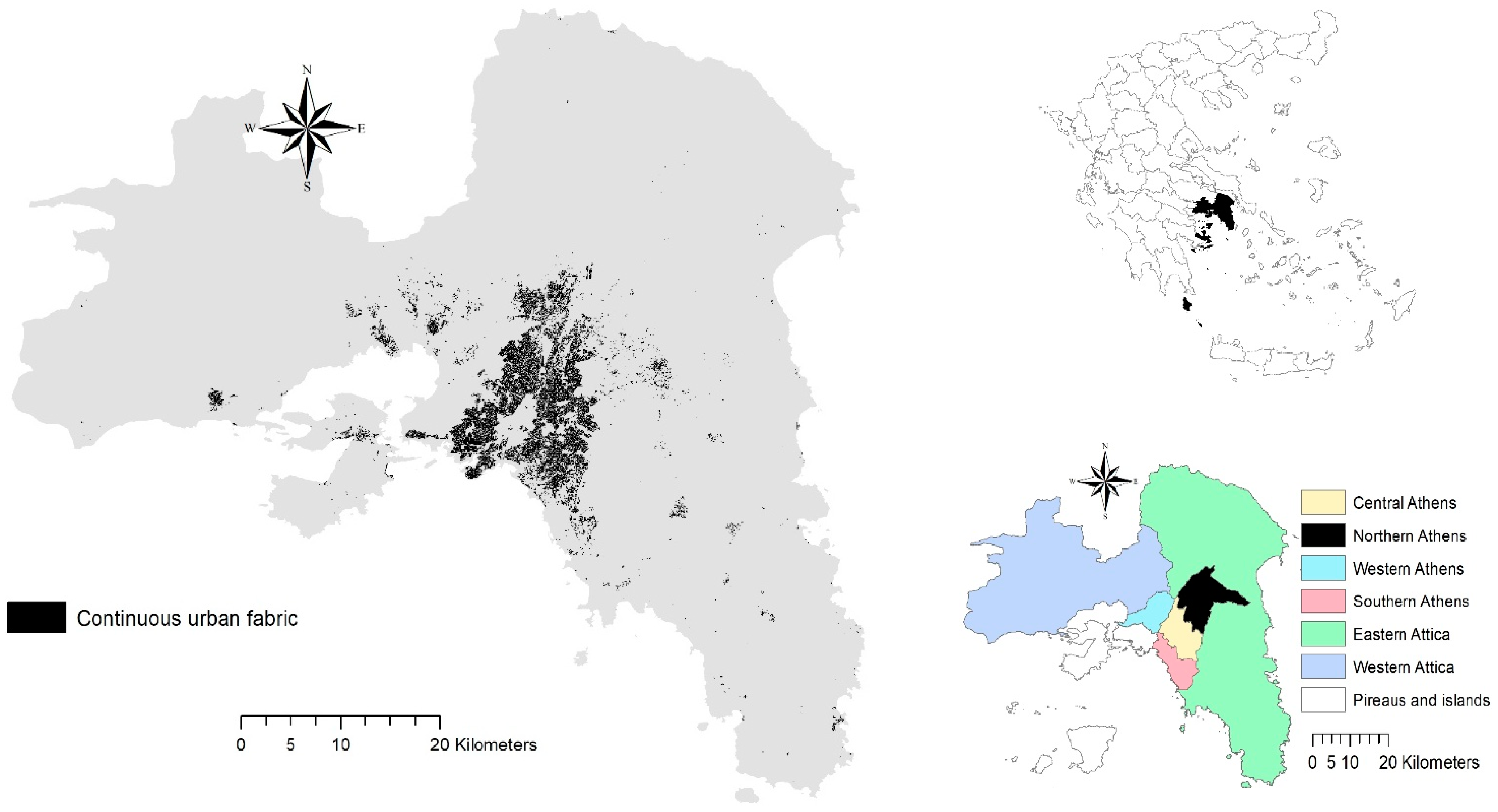
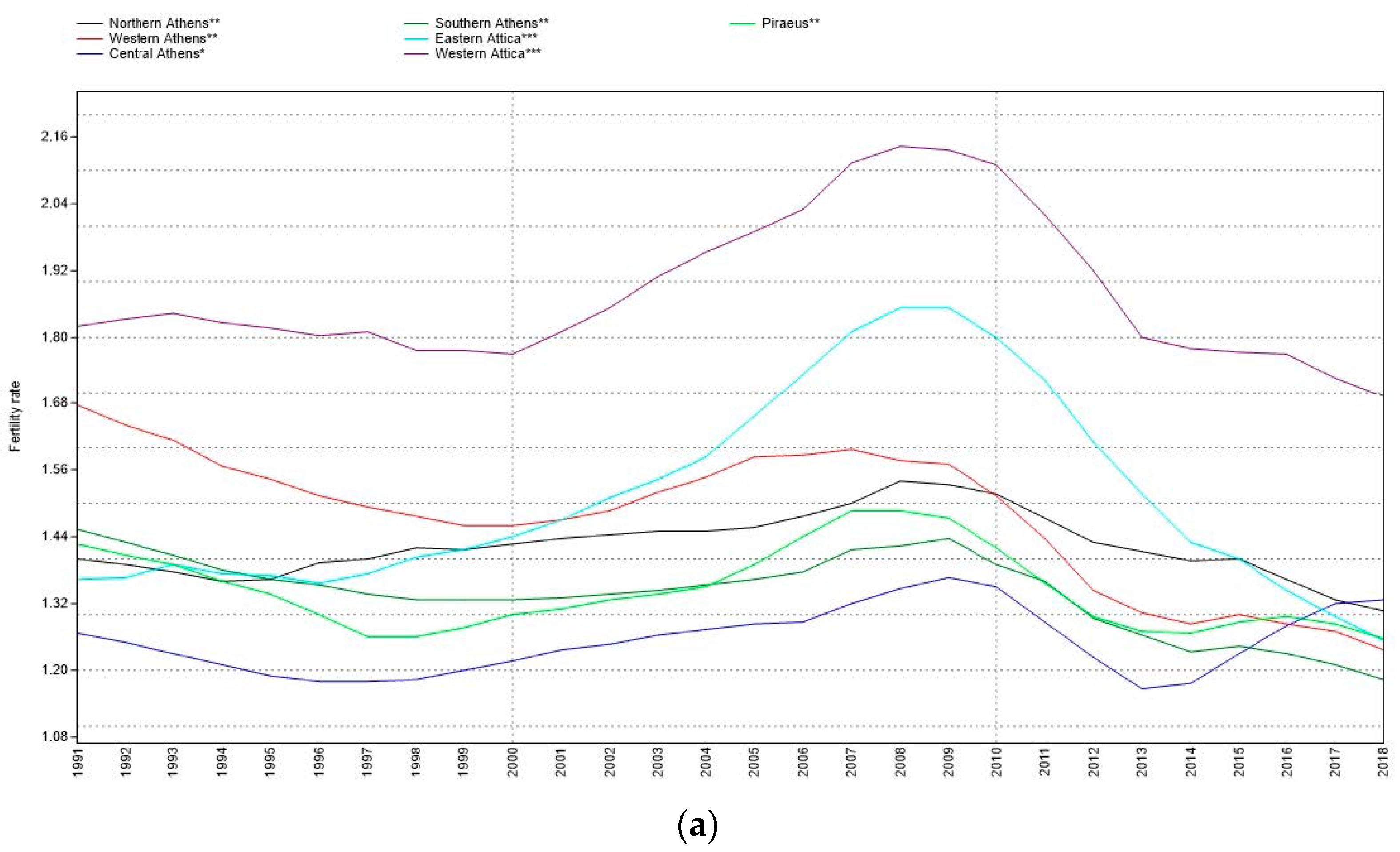

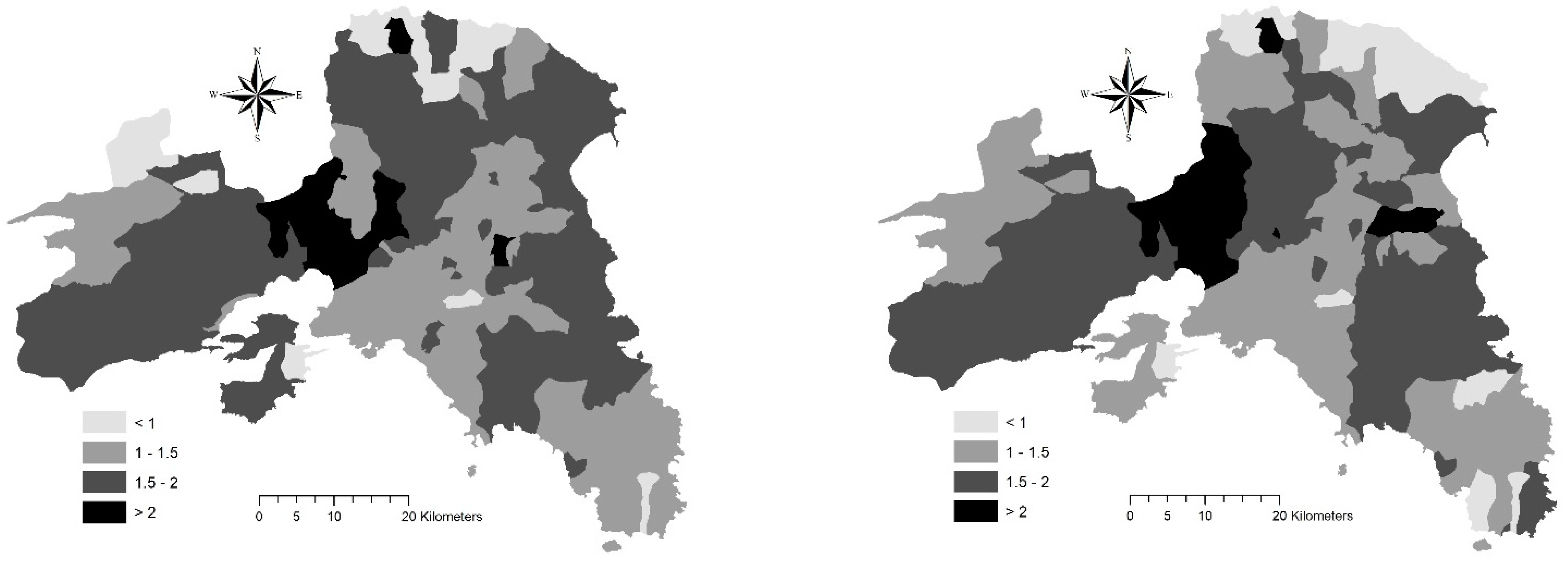
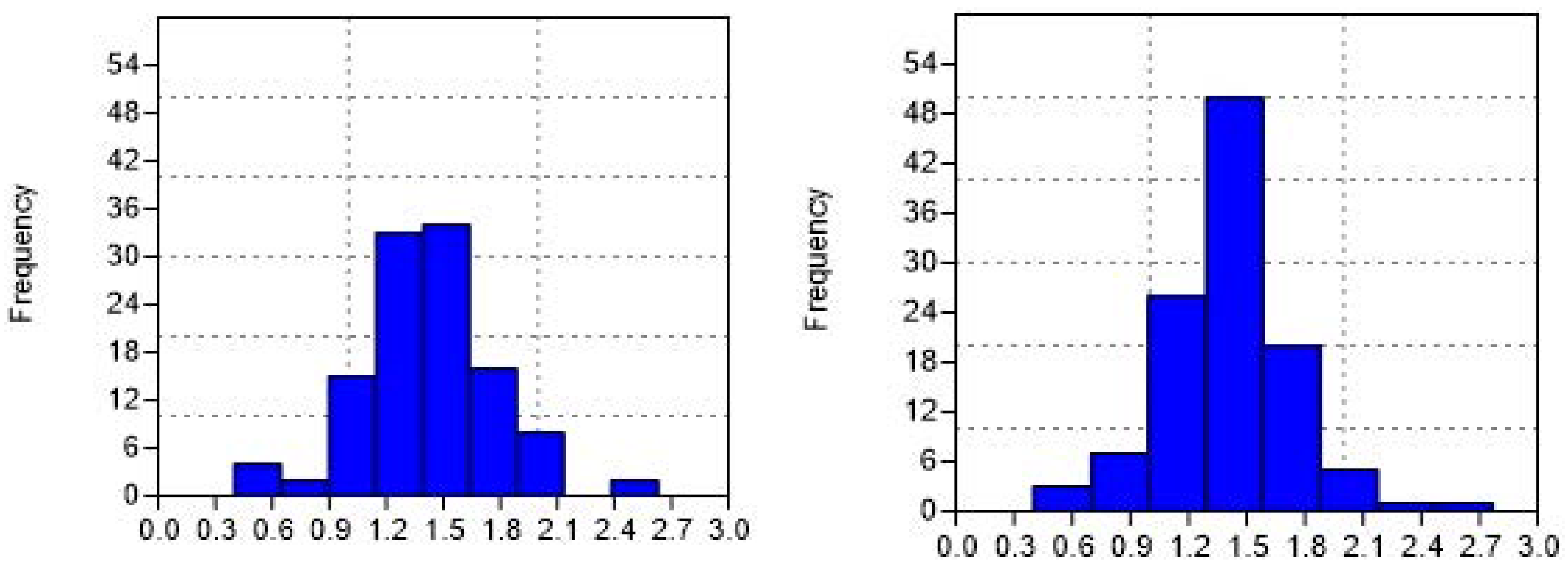
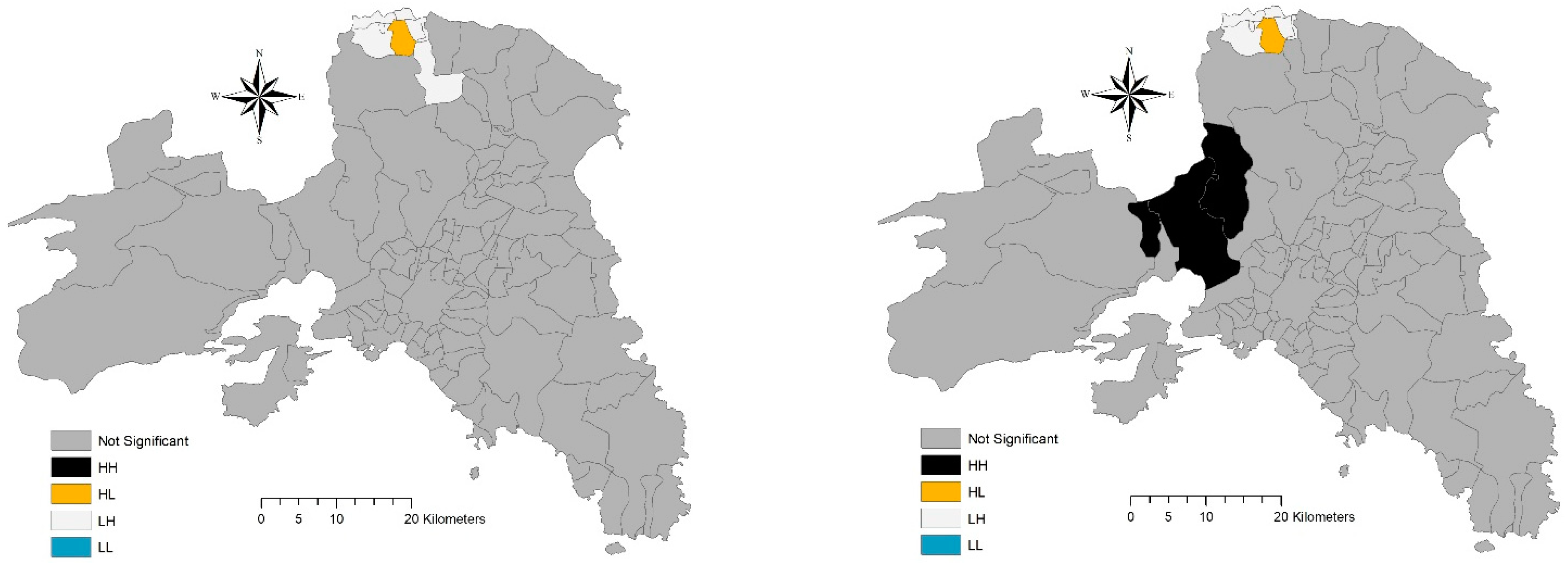
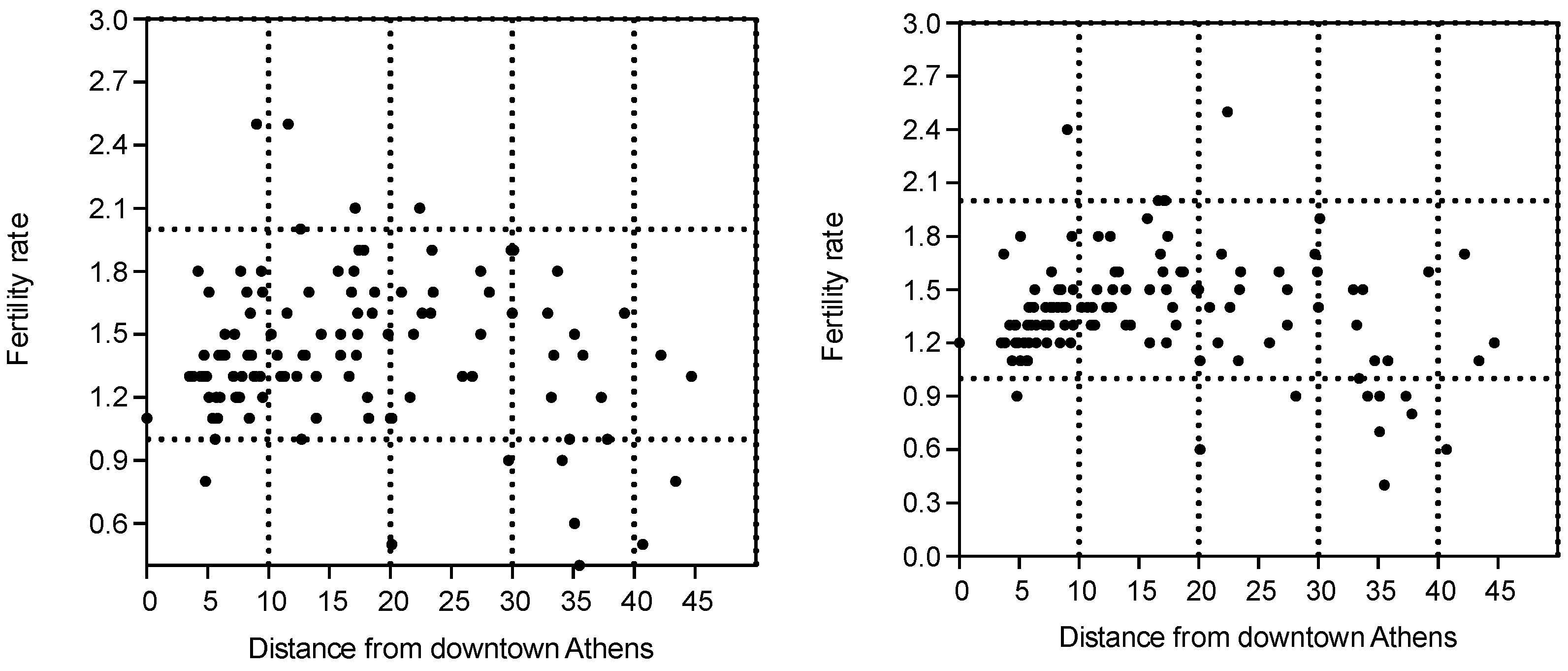
| District | Gross Fertility Rate | ||
|---|---|---|---|
| 1991–2000 | 2000–2008 | 2009–2018 | |
| Central Athens * | 1.21 | 1.28 | 1.27 |
| Piraeus ** | 1.33 | 1.38 | 1.32 |
| Northern Athens ** | 1.39 | 1.46 | 1.42 |
| Western Athens ** | 1.55 | 1.54 | 1.35 |
| Southern Athens ** | 1.37 | 1.37 | 1.29 |
| Eastern Attica *** | 1.38 | 1.63 | 1.52 |
| Western Attica *** | 1.81 | 1.97 | 1.87 |
| Attica, Grand Total | 1.35 | 1.43 | 1.37 |
| Bandwidth (km) | Coefficient (p-Level) | |
|---|---|---|
| 1999–2008 | 2009–2018 | |
| 5 | −1.46 (0.14) | −1.34 (0.18) |
| 10 | −0.53 (0.59) | −0.22 (0.83) |
| 20 | −0.62 (0.53) | −0.03 (0.97) |
| 40 | −0.72 (0.47) | −0.32 (0.75) |
| Indicator | 1999–2008 | 2009–2018 | Difference |
|---|---|---|---|
| Climate quality index | 0.32 | ||
| Protected areas (dummy) | 0.24 | ||
| Municipal master plan approved (dummy) | −0.27 | ||
| Per-capita built-up area | 0.31 | ||
| One-dwelling buildings in total building stock | 0.25 | ||
| Industrial buildings in total building stock | 0.22 | ||
| Discontinuous Medium Density Urban Fabric (30–50%) | 0.23 | ||
| Fast transit roads and associated land | 0.3 | 0.41 | |
| Land without current use | 0.3 | 0.26 | |
| Mining activities in total activities | 0.25 | ||
| Energy activities in total activities | −0.22 | ||
| Construction activities in total activities | 0.31 | −0.26 | |
| Industrial activities at large | 0.3 | −0.3 | |
| Services at large | −0.23 | 0.26 | |
| Income growth rate during recession, 2008–2012 | 0.29 | 0.22 | |
| Population growth rate | 0.26 | 0.4 | −0.23 |
| Elderly index | −0.37 | −0.44 |
Publisher’s Note: MDPI stays neutral with regard to jurisdictional claims in published maps and institutional affiliations. |
© 2021 by the authors. Licensee MDPI, Basel, Switzerland. This article is an open access article distributed under the terms and conditions of the Creative Commons Attribution (CC BY) license (http://creativecommons.org/licenses/by/4.0/).
Share and Cite
Halbac-Cotoara-Zamfir, R.; Egidi, G.; Salvia, R.; Salvati, L.; Sateriano, A.; Gimenez-Morera, A. Recession, Local Fertility, and Urban Sustainability: Results of a Quasi-Experiment in Greece, 1991–2018. Sustainability 2021, 13, 1052. https://doi.org/10.3390/su13031052
Halbac-Cotoara-Zamfir R, Egidi G, Salvia R, Salvati L, Sateriano A, Gimenez-Morera A. Recession, Local Fertility, and Urban Sustainability: Results of a Quasi-Experiment in Greece, 1991–2018. Sustainability. 2021; 13(3):1052. https://doi.org/10.3390/su13031052
Chicago/Turabian StyleHalbac-Cotoara-Zamfir, Rares, Gianluca Egidi, Rosanna Salvia, Luca Salvati, Adele Sateriano, and Antonio Gimenez-Morera. 2021. "Recession, Local Fertility, and Urban Sustainability: Results of a Quasi-Experiment in Greece, 1991–2018" Sustainability 13, no. 3: 1052. https://doi.org/10.3390/su13031052
APA StyleHalbac-Cotoara-Zamfir, R., Egidi, G., Salvia, R., Salvati, L., Sateriano, A., & Gimenez-Morera, A. (2021). Recession, Local Fertility, and Urban Sustainability: Results of a Quasi-Experiment in Greece, 1991–2018. Sustainability, 13(3), 1052. https://doi.org/10.3390/su13031052









